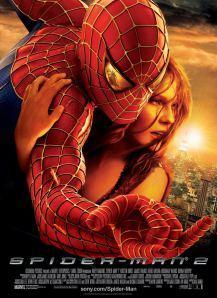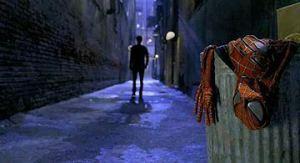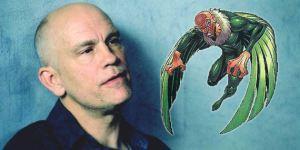Spider-Man (2002)

1. Sony/Columbia had been trying to get a piece of the Spider-Man film business since 1989, and thought it was in the driver’s seat after purchasing the film rights proper from Marvel in 1999. However, MGM also thought it was in the driver’s seat since part of the assets it acquired when purchasing Carolco Pictures after it went bankrupt in 1995 was the Spider-Man film rights and Spider-Man scripts going as far back as 1985. So, Columbia fought back, hitting MGM where it hurt: 007. Former MGM executive John Calley, now at Columbia, knew that producer Kevin McClory had the legal right to very select 007 properties outside of MGM’s control. MGM wasn’t about to let that happen since 007 was their only cash cow They wanted 007 more than they wanted Spider-Man, and vice-versa for Columbia. The two ultimately brokered a trade. Columbia officially purchased the Spider-Man rights and scripts from MGM in 2000.

Sony eventually got both Spider-Man and 007, saving MGM from its bankruptcy in 2004
2. Here’s where its gets complicated: though Columbia now had access to all prior Spider-Man scripts, they only optioned the James Cameron ones from the early 90s, including a brief “scriptment” featuring Sandman and Electro as villains and a 1993 screenplay credited to Cameron, Ted Newsom, John Brancato, Barney Cohen, and producer Manaheim Golan (under a pseudonym) featuring Doc Ock as the villain. David Koepp, then fresh off of The Lost World: Jurassic Park and Snake Eyes, was hired to update the Cameron material, which he mostly did by simply replacing Sandman and Electro with Green Goblin and Dock Ock. He kept Cameron’s idea of Spider-Man having organic web-shooters as well as Peter Parker no longer needing his glasses after the spider-bite. The problem is neither of those were entirely James Cameron’s ideas, as they were previously used in scripts which predated him in the Spider-Man film development cycle.

The organic web-shooters as described in James Cameron’s “scriptment”
Ted Newsom got a hold of the Koepp script, and realized that much of his work from the mid-80s was being re-used word for word because Cameron had re-used it word-for-word in the early 90s when he simply threw his name on the 1986 script. So, Newsom rallied support from all the other writers who had worked on a Spider-Man screenplay prior to James Cameron, and petitioned the WGA to ensure that Columbia gave credit where credit was due. Instead, WGA didn’t even read any of the scripts to compare, and determined that since Columbia had only optioned the Cameron material they didn’t owe anyone from before that 1993 period anything. Basically, the WGA told Newsom and friends to get lost, and sue the studio for copyright infringement if they felt so strongly about it (knowing full well they had no chance at winning or even being able afford pursuing such litigation).
3. Those weren’t the only writers with a legit claim to credit for the eventual Sam Raimi shooting script. Columbia hired both Scott Rosenberg (Con Air, High Fidelity) and Alvin Sargent (Julia, Ordinary People) to re-write Koepp’s script. Operating under Raimi’s orders, Rosenberg dropped Doc Ock from the script, even though they had already started pre-production and design work on the character. He also added in more action scenes while Sargent was asked to beef up the dialog between Peter and Mary Jane. Despite their efforts, Columbia only submitted Koepp’s name for credit with the WGA.

4. The studio didn’t want Tobey Maguire, then of Cider House Rules fame, as their Peter Parker. They wanted any one of the following: Leonardo DiCaprio, Chris Klein, Wes Bentley, or Heath Ledger. They even did a screen test with James Franco, their eventual Harry Osborn, as Spider-Man. Sam Raimi, on the other hand, wanted Maguire, but the studio was only won over after Maguire performed in the following screen test:
5. The following actors turned down the role of Norman Osborn before it finally fell to Willem Defoe: Nicholas Cage, John Malkovich, and John Travolta. How do we know? They all admitted as much in later interviews.
6. Sony was fined $58,805 by the California Division of Occupational Safety and Health after a 45-year-old construction worked died in an on-set accident.

7. Spider-Man is more closely associated with New York than most any other comic book character, and Sony’s advertising emphasized as much, releasing the above poster where you can see the World Trade Center in Spidey’s eye. After 9/11, that seemed like a very, very bad idea. So, all copies of the teaser poster were recalled, and the following trailer was pulled:
Spider-Man 2 (2004)

8. According to producer Laura Sizkin, there was pretty much no break for the development team between Spider-Man and Spider-Man 2. The actors had time to do other films, e.g., Tobey Maguire in Seabiscuit (2002), Kirsten Dunst in Eternal Sunshine of the Spotless Mind (2004). However, Sam Raimi and the production team barely had any time off. Sizkin recalled that her break between the two projects consisted of a 1-week vacation while Raimi may not have even taken a single day off.
9. Smallville co-creators Alfred Gough and Miles Millar were hired to write the script for Spider-Man 2 a month before Spider-Man even came out. David Koepp was later brought in as an uncredited co-writer, and the resulting draft featured the following villains: Doc Ock, The Lizard, Felicia “Black Cat” Hardy, and eventually even Harry Osborn as the New Green Goblin.

10. Pulitzer Prize-winning author Michael Chabon (Wonder Boys, The Amazing Adventures of Kavalier and Clay) was hired to re-write Gough, Millar, and Koepp’s draft. He simplified the story by dropping both Lizard, Black Cat, and the New Green Goblin, but his version still differed in significant ways from what we ended up seeing. He envisioned a younger version of Doc Ock involved in a love triangle with Mary Jane Watson and Peter Parker. Beyond that, this Doc Ock would turn out to be the creator of the spider which granted Parker his powers in the first film, and with such a level of expertise Ock would offer Peter an antidote to remove his powers. However, after a battle with Spider-Man Ock’s tentacles would fuse together, and the only way he could survive would be to somehow replace his spine with Peter Parker’s (huh?). Elsewhere, Harry Osborn would partner with J. Jonah Jameson in placing a bounty on Spider-Man’s head.
Nice try, Chabon, but take your Pulitzer and shove it. Sam Raimi looked at all of the drafts they had to that point, and picked the parts he liked, dropped what he didn’t. Along with Alvin Sargent, he decided they didn’t need any real scientific explanation for why Spider-Man begins losing his powers, and that Doc Ock should be molded after the Lizard in the comics as a sympathetic older mentor figure for Peter who is turned temporarily evil when his own experiment goes awry. Sargent ended up with sole credit for the screenplay while Gough, Millar, and Chagon earned story credits.

11. Tobey Maguire hurt his back while filming Seabiscuit. Plus, he was seeking a massive raise over the $3-4 million per-film he contracted he signed for the first Spider-Man. So, Columbia dang near re-cast the role of Spider-Man with Jake Gyllenhaal. If you don’t remember, the story was like tabloid catnip at the time because on top of everything else Gyllenhaal just happened to be dating Kirsten Dunst thus making it seem to some like Maguire was being pushed out for Dunst’s new boyfriend.

Maguire physically recovered, and ended up coming back for a reported $17 million payday. Suck it, Gyllenhaal! Years later, when it looked as if Maguire might drop out of Spider-Man 4 rumors again emerged that perhaps the studio would replace him with Gyllenhaal. That was likely just idle speculation, but during the Spider-Man 2 days Sony did legitimately take meetings with Gyllenhaal and begin contract negotiations.
12. Did this shot look familiar to you?:

If not, then you don’t know your comics. It’s an exact homage to “Spider-Man No More”, Issue #50 of The Amazing Spider-Man, from which Spider-Man 2 drew its inspiration (along with Superman 2) for the idea of Peter Parker walking away from his life as a superhero:

13. The hobo who offers the discarded Spider-Man suit to the Daily Bugle was likely meant as an inside joke about an incident with the first Spider-Man film when four Spider-Man costumes were stolen from the set. Columbia offered a $25,000 reward, and 18 months after the theft they discovered the culprit was a former movie studio security guard and an accomplice.

14. Doc Ock’s pier lair was such a complicated set it took 15 weeks to build, forcing filming to take a 8-week hiatus while awaiting the completion of the set.
Spider-Man 3 (2007)

15. The original story, written by Sam Raimi’s brother Ivan in 2 months, featured Sandman as the villain, and the Vulture as the secondary villain, with Harry Osborn’s New Green Goblin somewhere in-between. Eddie Brock was a minor character who acted as a mirror to Peter, both working a similar profession as him at the Daily Bugle and having his own steady girlfriend (who was not originally Gwen Stacy).
16. Producer Avi Arad talked Raimi into using Venom as the secondary villain instead of Vulture as well as having Brock’s girlfriend be Gwen Stacy. His reasoning for the former was mostly that Venom was so immensely popular in the comics that they could no longer delay using him in the films, despite Raimi’s prior objections. Raimi would later claim that further into development he grew to like the character of Venom, but kept up appearance about disliking and not understanding the character in interviews to throw off the scent for fans looking for hints as to who would be the villain for Spider-Man 3.
17. Alvin Sargent had secured a big payday for Spider-Man 2 and 3 (and potentially 4). However, as the producers kept forcing Raimi and him to add more comic book characters into the screenplay he considered splitting it into two films. Why didn’t he? He couldn’t pinpoint a natural and satisfactory stopping point at which to cut the story in half.

18. Thomas Haden Church broke 3 of his knuckles during the subway chase scene since the foam brick he was meant to punch into had not actually been put into place yet.
19. Composer Danny Elfman, whose work on Spider-Man 2 had been supplemented by an uncredited Christopher Young, initially refused to return for Spider-Man 3, vowing to never again work with Sam Raimi after suffering through a miserable working relationship with him on 2. Oddly, within a month of that news came the announcement that Elfman and Young would collaborate on the score for Spider-Man 3. If true, his work was uncredited since only Young received credit for the film’s musical score.
20. With a budget of $258 million, Spider-Man 3 was the most expensive film ever made at the time, a record it only held for 3 weeks since Pirates of Caribbean: At World’s End and its $300 million budget was released that same summer. We’re only talking official budgets, though. Industry experts have calculated that Sony likely actually spent $350 million to make Spider-Man 3 due to so much location shooting in New York, and re-shoots which extended the the production by about 8 months. Plus, they basically invented the technology required to depict Sandman.
21. As of 2014, Spider-Man 3‘s worldwide gross of $890.9 million makes it the third highest-grossing Marvel Comics film of all time, behind The Avengers ($1.5 billion) and Iron Man 3 ($1.2 billion). It was the highest-grossing film in Sony’s history until Skyfall broke the $1 billion barrier worldwide in 2012.
Spider-Man 4 -Unproduced


22. Spider-Man 4 was supposed to come out on May 6, 2011, but it never left development hell. Raimi, Maguire, and Dunst were all set to return, and the villains under consideration were The Lizard (played in his pre-transformation Curt Connors phase by Dylan Baker in Spider-Man 2 and 3), Vulture (with John Malkovitch aattached to the role), and Black Cat (with Anne Hatheway attached to the role).
23. The studio went through four different drafts from multiple screenwriters (i.e., James Vanderbilt, David Koepp, David Lindsay-Abaire, and Gary Ross), and even talked to Vanderbilt about maybe writing Spider-Man 5 and 6, which they hoped to film back-to-back.
24. Sam Raimi walked away in 2010 since he hated all the scripts they had, and would not be rushed into meeting the 2011 release date.
Sources: Wikipedia.org, “Making the Amazing” 12-part documentary from the Spider-Man 2 DVD, LA Times, WhatCulture

